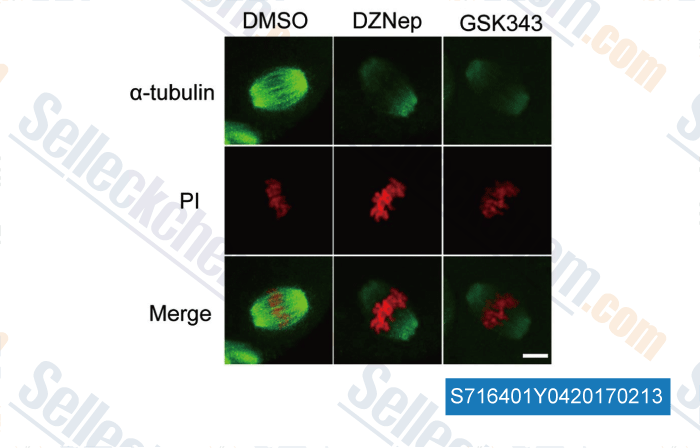|
Toll Free: (877) 796-6397 -- USA and Canada only -- |
Fax: +1-832-582-8590 Orders: +1-832-582-8158 |
Tech Support: +1-832-582-8158 Ext:3 Please provide your Order Number in the email. |
Technical Data
| Formula | C31H39N7O2 |
||||||||||||||
| Molecular Weight | 541.69 | CAS No. | 1346704-33-3 | ||||||||||||
| Solubility (25°C)* | In vitro | DMSO | 100 mg/mL (184.6 mM) | ||||||||||||
| Ethanol | 4 mg/mL (7.38 mM) | ||||||||||||||
| Water | Insoluble | ||||||||||||||
| In vivo (Add solvents to the product individually and in order) |
|
||||||||||||||
|
* <1 mg/ml means slightly soluble or insoluble. * Please note that Selleck tests the solubility of all compounds in-house, and the actual solubility may differ slightly from published values. This is normal and is due to slight batch-to-batch variations. * Room temperature shipping (Stability testing shows this product can be shipped without any cooling measures.) |
|||||||||||||||
Preparing Stock Solutions
Biological Activity
| Description | GSK343 is a potent and selective EZH2 inhibitor with IC50 of 4 nM in a cell-free assay, showing 60 fold selectivity against EZH1, and >1000 fold selectivity against other histone methyltransferases. GSK343 induces autophagy. | ||||
|---|---|---|---|---|---|
| Targets |
|
||||
| In vitro | GSK343 inhibits trimethylation of H3K27 (H3K27me3) with IC50 of 174 nM in HCC1806 breast cancer cells. GSK343 potently inhibits cell proliferation in breast cancer cells and prostate cancer cells, and the prostate cancer cell line LNCaP is the most sensitive to GSK343, with IC50 of 2.9 μM. [1] GSK343 significantly suppresses the growth of EOC cells cultured in 3D matrigel extracellular matrix (ECM), which mimics the tumor microenvironment in vivo. In addition, GSK343 also induces apoptosis of EOC cells in 3D and significantly inhibits the invasion of EOC cells. [2] |
||||
| In vivo | GSK343, a selective EZH2 inhibitor, inhibits phagocytosis. |
||||
| Features | A chemical probe for the SGC epigenetics initiative. Potential use in a variety of solid tumors. |
Protocol (from reference)
| Kinase Assay: |
|
|---|---|
| Cell Assay: |
|
References
|
Customer Product Validation

-
Data from [ , , Nucleic Acids Res, 2016, 44(16):7659-72. ]

-
Data from [ , , Oncogene, 2015, 10.1038/onc.2015.38 ]

-
Data from [ , , Mol Cancer, 2017, 16(1):5. ]
Selleck's GSK343 Has Been Cited by 64 Publications
| The establishment of nuclear organization in mouse embryos is orchestrated by multiple epigenetic pathways [ Cell, 2025, S0092-8674(25)00396-4] | PubMed: 40273908 |
| Inhibition of Mitochondrial Fission Reverses Simulated Microgravity-Induced Osteoblast Dysfunction by Enhancing Mechanotransduction and Epigenetic Modification [ Research (Wash D C), 2025, 8:0602] | PubMed: 39906534 |
| GSK343, an inhibitor of EZH2, prevents acquired cisplatin resistance in bladder cancer [ Mol Genet Genomics, 2025, 300(1):63] | PubMed: 40550924 |
| Dietary phytosterols induce infertility in female mice via epigenomic modulations [ Commun Biol, 2024, 7(1):1535] | PubMed: 39562830 |
| LINC01021 Attenuates Expression and Affects Alternative Splicing of a Subset of p53-Regulated Genes [ Cancers (Basel), 2024, 16(9)1639] | PubMed: 38730591 |
| Select EZH2 inhibitors enhance viral mimicry effects of DNMT inhibition through a mechanism involving NFAT:AP-1 signaling [ Sci Adv, 2024, 10(13):eadk4423] | PubMed: 38536911 |
| Polycomb repressor complex 2 suppresses interferon-responsive MHC-II expression in melanoma cells and is associated with anti-PD-1 resistance [ J Immunother Cancer, 2023, 11(11)e007736] | PubMed: 38315170 |
| Targeting polycomb repressor complex 2-mediated bivalent promoter epigenetic silencing of secreted frizzled-related protein 1 inhibits cholangiocarcinoma progression [ Clin Transl Med, 2023, 13(12):e1502] | PubMed: 38050190 |
| H3K27me3 of Rnf19a promotes neuroinflammatory response during Japanese encephalitis virus infection [ J Neuroinflammation, 2023, 20(1):168] | PubMed: 37480121 |
| H3K27me3 of Rnf19a promotes neuroinflammatory response during Japanese encephalitis virus infection [ J Neuroinflammation, 2023, 20(1):168] | PubMed: 37480121 |
RETURN POLICY
Selleck Chemical’s Unconditional Return Policy ensures a smooth online shopping experience for our customers. If you are in any way unsatisfied with your purchase, you may return any item(s) within 7 days of receiving it. In the event of product quality issues, either protocol related or product related problems, you may return any item(s) within 365 days from the original purchase date. Please follow the instructions below when returning products.
SHIPPING AND STORAGE
Selleck products are transported at room temperature. If you receive the product at room temperature, please rest assured, the Selleck Quality Inspection Department has conducted experiments to verify that the normal temperature placement of one month will not affect the biological activity of powder products. After collecting, please store the product according to the requirements described in the datasheet. Most Selleck products are stable under the recommended conditions.
NOT FOR HUMAN, VETERINARY DIAGNOSTIC OR THERAPEUTIC USE.
